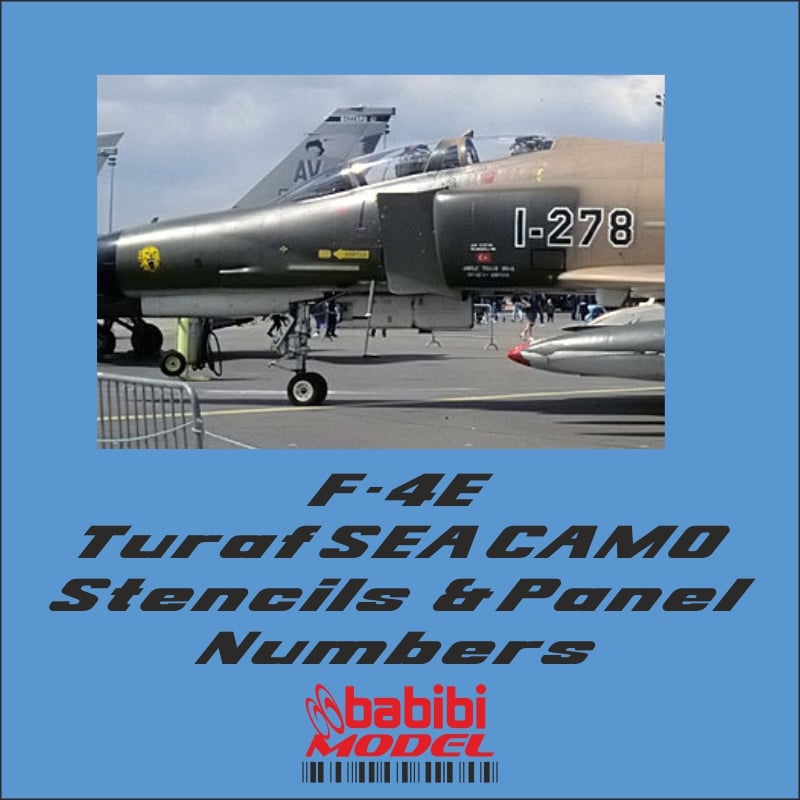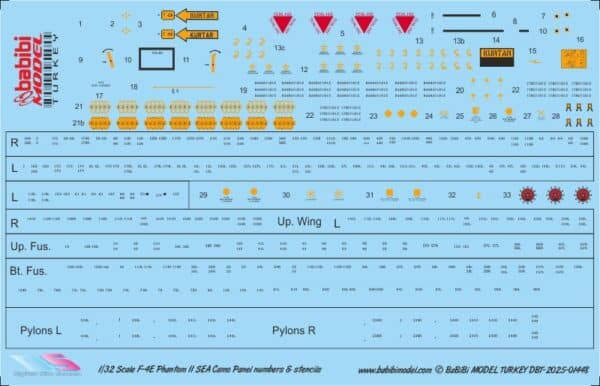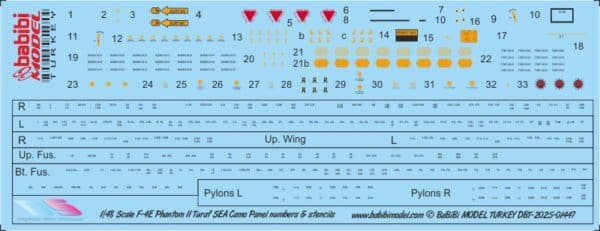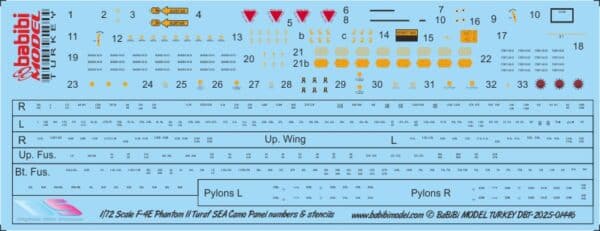Babibi Models Unveils the Essential Upgrade: F-4E TUrAF Sea Camo Stencils

Babibi Models Unveils the Essential Upgrade: F-4E TUrAF Sea Camo Stencils—Precision Painting for the Phantom
Achieve ultimate realism on your Turkish Air Force (TUrAF) F-4E Phantom II model with Babibi Models’ new line of precision painting stencils (DBT-01446/7/8). Say goodbye to decal silvering and capture the authentic, weathered look of the classic SEA camouflage. Available in 1/72, 1/48, and 1/32 scales, these sets offer an inexpensive ($7.00 – $12.00) solution for museum-quality stenciling on the legendary Rhino.
For the dedicated scale modeler, the journey to a museum-quality finish is often a battle fought not with glue and plastic, but with microscopic details that defy convention. The vast, complex surface of a fighter jet like the F-4 Phantom II is a canvas demanding intricate precision—a requirement that reaches its zenith with the application of countless technical markings, stencils, and panel numbers. These details are the visual bedrock of realism, yet applying them often introduces the modeler’s nemesis: the dreaded decal silvering.
Fortunately, specialist manufacturers are continually innovating to solve these chronic problems. Babibi Models, a name quickly gaining recognition for its high-quality detailing solutions, has launched a highly anticipated series of painting stencils designed to bring unparalleled realism to one of the Phantom’s most striking variants: the F-4E in Turkish Air Force (Türk Hava Kuvvetleri – TUrAF) service, particularly those wearing the classic Southeast Asia (SEA) camouflage scheme.
The new product line, comprising three distinct sets for different modeling scales—DBT-01446 (1/72), DBT-01447 (1/48), and DBT-01448 (1/32)—is the definitive answer for modelers seeking an authentically ‘painted-on’ look for their TUrAF Phantoms. Starting at an astonishingly accessible $7.00 and topping out at $12.00, these stencil sets shatter the notion that ultimate realism must come at a premium, making them an essential, yet budget-friendly, upgrade for any serious Phantom enthusiast.
The Phantoms of Anatolia: Turkey’s Enduring Service with the F-4E
To appreciate the necessity of such detailed stencil sets, one must first immerse oneself in the storied history of the F-4E Phantom II with the Turkish Air Force. Turkey’s operational history with the Phantom is one of the type’s longest and most sustained globally, showcasing remarkable adaptability and strategic commitment.
Turkey first acquired the F-4E in the mid-1970s under the “Peace Diamond I” program, a crucial initiative to modernize its tactical fleet as regional tensions escalated. Subsequent batches—acquired under programs like “Peace Diamond III” and “Peace Diamond IV”—steadily built the TUrAF’s Phantom inventory to well over 200 units. The rugged, reliable F-4E quickly became a cornerstone of Turkish air power, fulfilling critical fighter-bomber and reconnaissance roles for decades. The jet’s ability to carry a massive payload and its durable airframe ensured its longevity, cementing its status as the TUrAF’s main workhorse alongside the later F-16 Fighting Falcon.
Throughout the 1970s and 1980s, the dominant livery for these formidable jets was the SEA (South East Asia) camouflage. This iconic three-tone scheme of Dark Green (FS34079), Medium Green (FS34102), and Tan (FS30219) on the upper surfaces, contrasted with the Light Gray (FS36622) belly, visually linked the Turkish Phantoms to their American counterparts in Vietnam. However, the Turkish application, subject to local depot maintenance practices and the harsh, often arid conditions of Anatolian bases, developed its own unique character and weathering patterns.
The Allure of the SEA Scheme and the Stenciling Conundrum
The SEA camouflage, with its clearly defined demarcations and contrasting color palette, is inherently attractive to modelers. Yet, the challenge goes far beyond simply applying the color boundaries. The true test of a realistic Phantom model lies in the thousands of technical markings that plaster the airframe—from “NO STEP” warnings to hydraulic system access identifiers.
Historically, the visibility of these stencils was paramount, necessitating a two-color convention on the camouflage: stencils were painted White over the dark greens, and Black (or dark gray) over the tan and light gray under-surfaces.
The crucial historical detail that elevates this specific stencil set to an essential item is the variability of depot maintenance. Photographic evidence of TUrAF Phantoms shows a fascinating inconsistency in stenciling. Aircraft repainted at different times or bases often received different stencil packages. Some were heavily stenciled, others minimally so. Furthermore, the practice of on-base touch-ups meant that stencils were often painted over, partially obscured, or applied in slightly different shades, reflecting the aircraft’s operational life. This subtle, weathered complexity is the essence of realism that traditional decals inherently fail to capture.
The Decal Dilemma: Why Babibi Models’ Stencils are Superior
Traditional waterslide decals, while convenient for large unit badges, are fundamentally limited in replicating the intricate, ‘painted-on’ look of operational stenciling for several critical reasons:
- Silvering is the Enemy: The most common and frustrating issue is silvering, where air trapped under the clear carrier film creates an unnatural, reflective sheen. This phenomenon is amplified on dark, flat camouflage surfaces and is nearly impossible to eliminate entirely on every one of the hundreds of tiny technical stencils.
- Conformity and Detail Loss: The F-4’s airframe is a landscape of rivets, inspection hatches, and access panels. Decals struggle to conform to these three-dimensional details, often bridging panel lines or requiring heavy, potentially damaging, application of chemical setting solutions.
- Unrealistic Weathering Integration: A decal is a foreign, film-based layer on top of the paint. This makes integrating it into the surrounding weathering virtually impossible. When a modeler applies fading, oil washes, or paint chipping, the decal often resists these effects, maintaining a stark, ‘factory-fresh’ look that betrays the weathered state of the rest of the model.
Babibi Models’ stencil sets directly solve this dilemma by eliminating the clear carrier film entirely. By allowing the modeler to paint the markings, they ensure the stencils become an integral part of the paint job.
Technical Review: Precision Across Three Scales
Babibi Models’ commitment to accessibility and accuracy is evident in the strategic release across three major scales. Whether a modeler prefers the massive detail of 1/32 (DBT-01448), the popular balance of 1/48 (DBT-01447), or the space-saving intricacy of 1/72 (DBT-01446), there is a dedicated set.
The stencils themselves are typically manufactured from high-quality, low-tack masking material, such as vinyl or Kabuki tape, renowned for its clean edges and ability to peel away without residue.
Core Technical Value of the Stencils:
- Correct Turkish Typography: The sets are designed with the specific typeface, character spacing, and panel number formats used by the Turkish maintenance depots, ensuring an authenticity that generic sheets often overlook.
- Dual-Color Necessity: They provide a vast array of markings necessary for the TUrAF SEA scheme, crucially offering many stencils in both Black and White. This empowers the modeler to adhere to the rule of contrast: using the white stencils on the dark green areas and the black stencils on the tan and light gray areas.
- Weathering Capability: This is the paramount feature. Once the stencil is painted, the marking is literally part of the paint layer. This allows the modeler to:
- Subtly Fade: Airbrush a highly diluted coat of the surrounding camouflage color over the stencil to simulate sun bleaching.
- Integrate Washes: Apply panel line washes that flow directly over and around the stencil, cementing its painted appearance.
- Micro-Chip: Use micro-chipping techniques (like sponge chipping) that lightly degrade the stencil paint itself, perfectly simulating operational wear.
Exceptional Value Proposition:
The price range of $7.00 to $12.00 across the three scales is remarkable. Stencil sets of this complexity from other high-end manufacturers often cost significantly more. By making this level of detailing affordable, Babibi Models is democratizing precision, allowing more modelers to achieve the highest standards of realism.
The Final Step to Authenticity
The meticulous process of using stencils is not a shortcut; it is a commitment to quality. The final effect on the model—the crisp lines, the perfect color contrast, and the seamless integration into a weathered surface—is undeniable. The Turkish F-4E Phantom II, whether in its original SEA guise or later in the Terminator 2020 configuration, is a machine built on grit and resilience. Its paint scheme and the myriad of technical data etched onto its surface tell the story of its demanding operational life.
Babibi Models’ F-4E TUrAF Sea Camo Stencils are the most effective tool available today to tell that story accurately. They transform the challenging process of stenciling into a controlled, rewarding step, allowing the 1/48 scale Phantom builder (or 1/72, or 1/32) to capture the authentic, thunderous spirit of the Anatolian Rhino. This is an essential release that sets a new standard for detailing one of the greatest fighter jets in aviation history. Don’t let your next TUrAF F-4E build fall victim to silvering; equip yourself with the tools of a professional.



